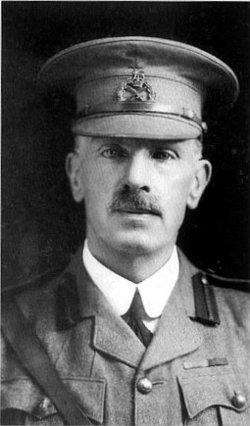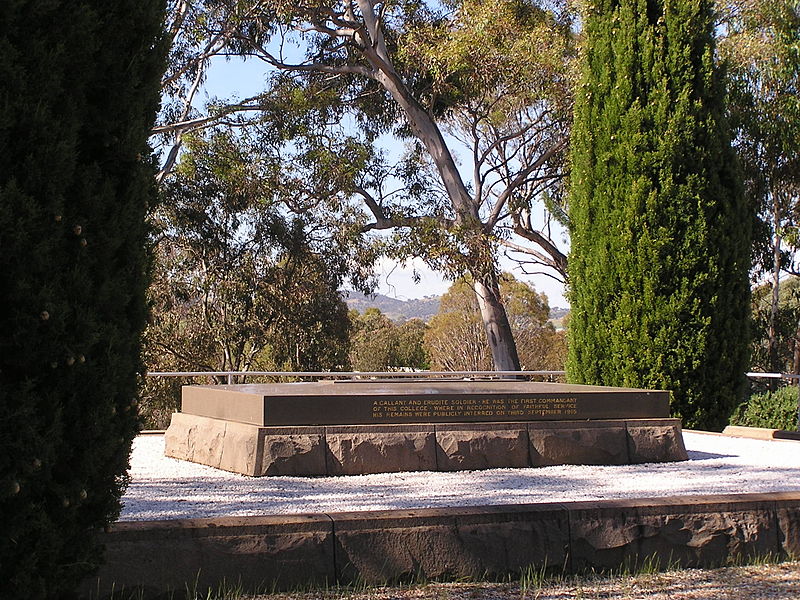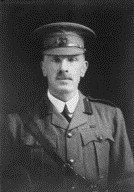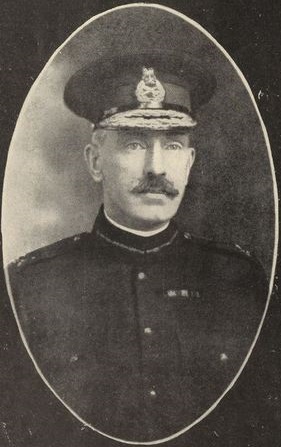1st Divisional Headquarters Australian Imperial Force
Born February 18, 1861 in Greenock, Scotland, the son of William Wilson Somerset Bridges (a Royal Navy captain) and Mary Hill Throsby, he was educated at Ryde on the Isle of Wight, at the Royal Naval School 1871-2 at New Cross, London and at Trinity College School (1873–1876) Port Hope, Ontario, Canada. He studied at the Royal Military College of Canada in Kingston, Ontario, Canada, student number 25 from 1877-9 and obtained his M.Q. certificate. Cadet Bridges was one of the recruits who had entered RMC Kingston late in the second term on 10 April 1877. Although he was a good student, he became unsettled and began failing his courses when his family migrated to Australia leaving him in Kingston. Commandant Hewett asked his father to pay a $100 fine to withdraw his son. This ex-cadet was the first RMC dropout.
In 1879 he joined his family who had settled in his mother's home town of Moss Vale, New South Wales.
In 1886, he received a commission into the New South Wales Permanent Artillery stationed at Middle Head. In 1890 he was then sent for training to the United Kingdom at the Royal Military Academy, Woolwich and at the Royal School of Gunnery at Shoeburyness. Upon returning to Australia in 1893 he became Chief Instructor at the Middle Head School of Gunnery. He volunteered for service in the British Army in the Second Boer War of 1899–1902, from where he contracted typhoid. After being evacuated to England, he returned to Australia in September 1900, from where rapid promotions followed: Assistant Quartermaster General of the Army HQ in Melbourne; Chief of Military Intelligence; Chief of the Australian General Staff. In 1909 he went to England as Australia's representative on the Imperial General Staff.
In 1909-10 Colonel W. Throsby Bridges reported to the Australian Minister of Defence that on his way home to establish the Australian Military College, he had inspected his alma mater Royal Military College of Canada. A copy of Bridges' diary is in the Masey Library at the Royal Military College of Canada. Bridges felt that the RMC Kingston system, by which officers were trained for the reserve as well as for all arms of a regular force trained officers without getting full use of their services after graduation. Consequently, with the international scene getting darger, he copied the West Point system, by which only regular army officers were trained via a four-year course training for all arms.
In 1910 Bridges was promoted to Brigadier General and (on the recommendation of Lord Kitchener) was recalled to Australia to become the first Commandant of the Royal Military College at Duntroon. He chose the site of the old Campbell homestead. In line with the recommendations of Lord Kitchener, Bridges largely modelled Duntroon on the United States Military Academy at West Point.
In May 1914, Bridges was appointed Inspector General of the Army. He was in Queensland when the war began, and arrived in Melbourne on 5 August 1914. Bridges met with the cabinet and was charged with the creation of an expeditionary force of 20,000 men for overseas service. He chose much of his staff from available graduates from the Duntroon college.
vvBridges and his command sailed from Albany, Western Australia, on 26 October 1914. En route, the destination was changed from England to Egypt and Bridges arrived there on 30 November 1914. As commander of the 1st Australian Division, Bridges landed at Anzac Cove, Gallipoli at around 7:30am on 25 April 1915.
While touring the lines on 15 May 1915, Bridges was shot through the femoral artery by a Turkish sniper. Dragged to safety, he was evacuated to the hospital ship Gascon. Infection set in but amputation was deemed impossible since he had lost so much blood.
Made aware of Bridges' imminent death, King George V knighted him on 17 May. He died the following day on board the hospital ship.
His body was returned to Melbourne where he received a state funeral. He was buried on 3 September 1915 at Duntroon on the slopes of Mount Pleasant. The grave was designed by Walter Burley Griffin, the designer of Canberra. A bridge at the Majura Training Area was unofficially named General Grave's Bridge (A play on General Bridge's Grave)
As an ex-cadet, his name is listed on the Memorial Arch at the Royal Military College of Canada in Kingston, Ontario. He is commemoriated on the Canadian Virtual War Memorial and on page 566 of the Canadian First World War Book of Remembrance.
On 10 October 1885 Bridges married Edith Lilian Francis (1862–1926), daughter of Alfred John Dawson Francis and Margaret Agnes Anne Francis (formerly Wilson, born Green) at St John's Church, Darlinghurst, New South Wales. They had seven children, three of whom died young.
He was survived by "Sandy", the only (Australian) Waler horse to return from World War I (due to quarantine restrictions). It is not clear when Bridges met Sandy but after his death Sandy was cared for by a number of Army vets until, by order of the Minister of Defence, Sandy was returned to Australia where he lived at the Remount Depot at Maribyrnong.
died aged 54
Awards: Mentioned in Despatches
Additional information: Memorial at Mt. Pleasant Lookout, Duntroon Military College.
(GRM/2*).
1st Divisional Headquarters Australian Imperial Force
Born February 18, 1861 in Greenock, Scotland, the son of William Wilson Somerset Bridges (a Royal Navy captain) and Mary Hill Throsby, he was educated at Ryde on the Isle of Wight, at the Royal Naval School 1871-2 at New Cross, London and at Trinity College School (1873–1876) Port Hope, Ontario, Canada. He studied at the Royal Military College of Canada in Kingston, Ontario, Canada, student number 25 from 1877-9 and obtained his M.Q. certificate. Cadet Bridges was one of the recruits who had entered RMC Kingston late in the second term on 10 April 1877. Although he was a good student, he became unsettled and began failing his courses when his family migrated to Australia leaving him in Kingston. Commandant Hewett asked his father to pay a $100 fine to withdraw his son. This ex-cadet was the first RMC dropout.
In 1879 he joined his family who had settled in his mother's home town of Moss Vale, New South Wales.
In 1886, he received a commission into the New South Wales Permanent Artillery stationed at Middle Head. In 1890 he was then sent for training to the United Kingdom at the Royal Military Academy, Woolwich and at the Royal School of Gunnery at Shoeburyness. Upon returning to Australia in 1893 he became Chief Instructor at the Middle Head School of Gunnery. He volunteered for service in the British Army in the Second Boer War of 1899–1902, from where he contracted typhoid. After being evacuated to England, he returned to Australia in September 1900, from where rapid promotions followed: Assistant Quartermaster General of the Army HQ in Melbourne; Chief of Military Intelligence; Chief of the Australian General Staff. In 1909 he went to England as Australia's representative on the Imperial General Staff.
In 1909-10 Colonel W. Throsby Bridges reported to the Australian Minister of Defence that on his way home to establish the Australian Military College, he had inspected his alma mater Royal Military College of Canada. A copy of Bridges' diary is in the Masey Library at the Royal Military College of Canada. Bridges felt that the RMC Kingston system, by which officers were trained for the reserve as well as for all arms of a regular force trained officers without getting full use of their services after graduation. Consequently, with the international scene getting darger, he copied the West Point system, by which only regular army officers were trained via a four-year course training for all arms.
In 1910 Bridges was promoted to Brigadier General and (on the recommendation of Lord Kitchener) was recalled to Australia to become the first Commandant of the Royal Military College at Duntroon. He chose the site of the old Campbell homestead. In line with the recommendations of Lord Kitchener, Bridges largely modelled Duntroon on the United States Military Academy at West Point.
In May 1914, Bridges was appointed Inspector General of the Army. He was in Queensland when the war began, and arrived in Melbourne on 5 August 1914. Bridges met with the cabinet and was charged with the creation of an expeditionary force of 20,000 men for overseas service. He chose much of his staff from available graduates from the Duntroon college.
vvBridges and his command sailed from Albany, Western Australia, on 26 October 1914. En route, the destination was changed from England to Egypt and Bridges arrived there on 30 November 1914. As commander of the 1st Australian Division, Bridges landed at Anzac Cove, Gallipoli at around 7:30am on 25 April 1915.
While touring the lines on 15 May 1915, Bridges was shot through the femoral artery by a Turkish sniper. Dragged to safety, he was evacuated to the hospital ship Gascon. Infection set in but amputation was deemed impossible since he had lost so much blood.
Made aware of Bridges' imminent death, King George V knighted him on 17 May. He died the following day on board the hospital ship.
His body was returned to Melbourne where he received a state funeral. He was buried on 3 September 1915 at Duntroon on the slopes of Mount Pleasant. The grave was designed by Walter Burley Griffin, the designer of Canberra. A bridge at the Majura Training Area was unofficially named General Grave's Bridge (A play on General Bridge's Grave)
As an ex-cadet, his name is listed on the Memorial Arch at the Royal Military College of Canada in Kingston, Ontario. He is commemoriated on the Canadian Virtual War Memorial and on page 566 of the Canadian First World War Book of Remembrance.
On 10 October 1885 Bridges married Edith Lilian Francis (1862–1926), daughter of Alfred John Dawson Francis and Margaret Agnes Anne Francis (formerly Wilson, born Green) at St John's Church, Darlinghurst, New South Wales. They had seven children, three of whom died young.
He was survived by "Sandy", the only (Australian) Waler horse to return from World War I (due to quarantine restrictions). It is not clear when Bridges met Sandy but after his death Sandy was cared for by a number of Army vets until, by order of the Minister of Defence, Sandy was returned to Australia where he lived at the Remount Depot at Maribyrnong.
died aged 54
Awards: Mentioned in Despatches
Additional information: Memorial at Mt. Pleasant Lookout, Duntroon Military College.
(GRM/2*).
Family Members
Sponsored by Ancestry
Advertisement
Advertisement










